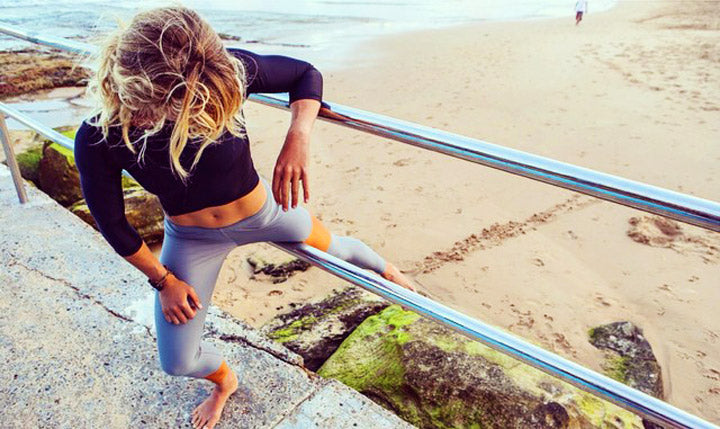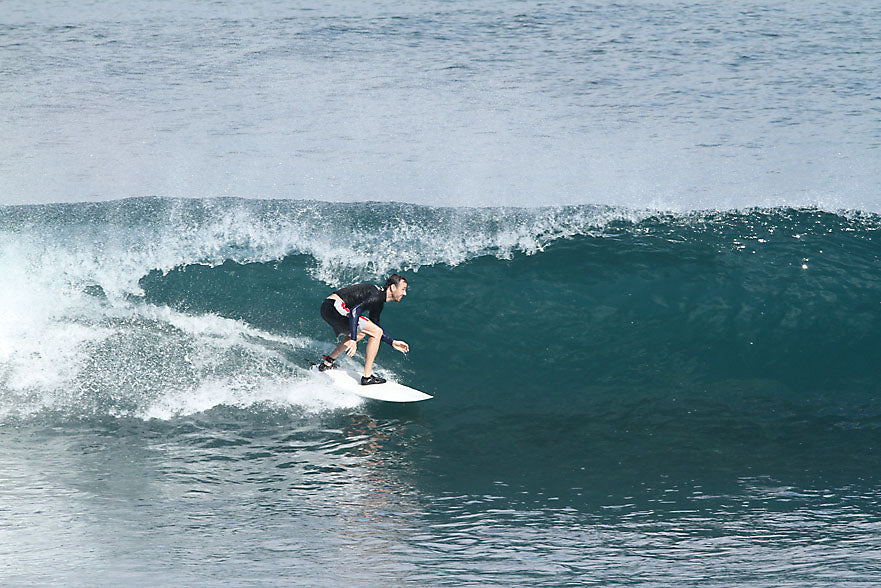Surfing Fitness: The ultimate introduction to fitness & surfing
It's 2018 and fitness and wellbeing is a topic that is brought up now, more than ever before. With research and studies being done around the world focusing on fitness, and how it improves your wellbeing, your mind, health, and life, I think it's time we take a look into how surfing can make you not only healthier, fitter, and a clearer mind but have fun whilst doing it.

Photo Credit: Still Stocked
If you're new to surfing, or a well-experienced rider understanding the fitness of surfing, and running a proper diet is important to know.
In this article, we're going to cover things like stretching before, and after riding, what to eat before, and after and the muscles that surfing works out, and why you should surf more regularly.
Like all our long articles, we like to include an index to help you through it!
- How times have changed
- Surf Training and Routines
- Warm-ups
- Training Workouts
- The future of surfing fitness
How times have changed
It wasn't that long ago that professional surfers would travel to exotic places, party hard, drink and eat what they want, when they want whilst living the high life.
Surfers are well respected, partying with rock stars and celebrities being paid to do what they love surfing the biggest and best waves, whilst enjoying life to it's fullest.
With hundreds of news articles negatively targetting and damaging the image of surfing, it was time to change.
Although a slow and gradual change over the years with newer research coming out, sponsors tightening up and tougher competition then ever before, the pro scene could be more different.
Treated like proper athletes or military training camps surfers are heading to bed early, waking up early and training day-in-day-out. Most pros now have nutritionists and eating plans to ensure they're eating, and drinking the correct things.

Sponsorships have also changed, healthy eating and organic food companies are now looking at surfers as influencers they're happy to put their name on, and the pros are loving it, pushing out sponsors like bud light and fast food outlets.
In today's pro scene, you'll find surfers like Julian Wilson, Owen Wright, Mick Fanning and Filipe Toledo just to name a few, men that are in their absolute prime, fitter then they have ever been!
To compete with today's tour pros you need to be at your absolute peak fitness, focusing on what you're eating, drinking and your working routines.
Surf Training and Routines
With surfing growing in popularity year on year, more and more money is being pushed into surf development, a notable area of this is in fitness, with dedicated instructors, therapists, and fitness centers being launched around the world such as the Hurley Surfing Australia High-Performance Center in NSW, Australia. Offering everything from personal trainers, fitness and nutrition programs and surf coaching, they're making huge breakthroughs in rider advancements.
Nutrition
Nutrition isn't just about eating healthy and looking and feeling good, but a proper diet and food plan can actually help avoid serious injuries and provide you with more energy, ultimately improving your performance.
Here are a few tips to ensuring a well-balanced diet for your next 4-hour surf session:
- Drink clean or purified water and stay properly hydrated, soft drinks, energy drinks, and soda are filled with artificially flavored liquids which do absolutely nothing to keep you healthy and hydrated.
- Eat real whole foods like fruits and vegetables and quality proteins and fats, this includes removing excessive sugars and processed foods from your diet completely.
- Eat well-balanced meals such as good fats like vegetable oils, high in protein and carbohydrates in every meal.
- Limit your alcohol intake, this is a general health rule that alcohol is doing nothing good for your diet and health.
- It's important that after surfing to replenish your muscles glycogen stores ( energy ) by eating fresh fruit and some kind of protein intake.
- Eat your breakfast before you surf, fruit and high in calcium breakfasts are the way to go.
- Eating 5 times a day is recommended by most nutritionists, this includes a proper full breakfast, snack, high protein lunch, fruit, and high protein, vegetables, and meat dinner.
Warm-ups
Your warm-up should consist of some of the mobility drills in which you would expect when out on the waves, the idea behind surf warm-ups is to increase your heart rate, release some tight tissues, joints and excite the nervous system.

Photo Credit: Totalsurfingfitness.com
Start by finding a good solid surface, be well hydrated and fed, warming up should be done before each and every surf outing, regardless of weather, temperature or time.
- Breathing Squat: This is done by performing a squat movement, exhaling whilst your body moves down, and inhaling on the way up with arms stretching up.
- T-Rotation Pushups: Begin by getting into a regular pushup position, rotate one arm into the sky, while simultaneously rotating your body onto one side. You're now balancing on one hand, with the other hand facing the sky, moving back into the pushup position and repeating.
- Single Leg Upper Body Rotation: Stand on one leg, bend your other leg slightly, and have your hips pushed out backwards with your arms in front of your body, rotate from side to side slowly. Make sure to remain balanced and rotate legs.
- Warrior Lunge: Stand up straight, and lunge forward extending your arms to the sky, push up off your front foot and back into a standing position.
- Bent Shoulder Circles: Ensure you're keeping a straight back, slightly bend your knees and move your torso forward. You'll start to feel a light stretch in your hamstring. Bring your arms out to the sides like a T-position, rotate your arms in a circle direction 30 times per arm.
- Butt Drops: With your arms reaching towards the sky, bend forward and touch your toes whilst moving your butt towards your heels as you lift your chest to face forward. Your elbows should be inside of your knees, pushing them outwards. Inhale, and exhale and repeat.
- Standing Knee Hugs: A pretty standard workout, stand with your spine tall and erect bringing one knee at a time towards your chest and holding.
You should now be warmed up, make sure to repeat these as many times as you need, you should now have a high heart rate and be warmed up.
Training Workouts
Although nothing can replicate what your body goes through whilst actually out on the waves, you can strengthen your body and replicate similar movements which will ultimately improve muscle strength and improve your surfing.
Full Body Movements
Unlike many other sports, water sports and in particular surfing, you're constantly moving in a three-dimensional space, surfing demands flexibility and strength, training your whole body can be done using the following:
- Kettlebell Swings
- Back Squats or Front Squats
- Dead Lifts
- Single Leg Dead Lifts
- Lunges and Multi-directional Lunges
- Plyometric Hops
- Single Arm Cable Pushes and Pulls
- Overhead Presses and Single Arm Overhead Presses
- Medicine Ball Chops
- Sprints
- Cable Chops
- Pushup Variations
- Pull-Ups/Chin-Ups
Whilst these can be done at most gyms, each gym exercise has its own body weight variant which you can simply lookup online.
Single Leg and Balance Practice
Without balance, you have no chance on a board, ensuring your training program include balance and core workouts is super important. Improved balance allows you to not only get up easier but maneuver your board and archive harder tricks with ease.
Start out by doing the following balance drills:
- Single Leg Balance with upper body medicine ball tosses
- Single Leg Cable Push or Pulls
- Exercises on top of a Balance Board or Indo Board
- Single Leg Exercises
- Bulgarian Split Squats
- Lunges
- Single Leg Dead Lifts
- Ice Skater Squats
- Single Leg Box Squats
Core Training
We all know that one friend, or family member who is constantly complaining about a sore lower back, or back pains. It's evident than core training isn't to be taken lightly. One of the more important aspects of your surf training will be a strong core.
Your core is used more than any other muscle in your body when surfing, it helps you maneuver your board, stand up, paddle and even balance. A strong core will typically get injured less as well.
We can work out the core by doing some of the following:
- Supine Lateral Ball Rolls
- Stability Ball Jack-Knife
- Medicine Ball Chops
- Cable Chops
- Paloff Press
- Horse Stance or Bird Dogs
- Stability Ball Rollouts
Shoulders and Upper Back
Shoulders and back are often the most forgotten exercises regardless of what you're training for, they're harder and typically take longer to build up then other parts, but in surfing, your shoulders and your back play an important role.
Paddling is undoubtedly the most exhausting aspect of surfing, putting your back and shoulders to work good and proper! It doesn't hurt to do some extra training, you never know you might improve your paddling speed in doing so.
There are many upper back and shoulder workouts, but we're trying to focus on replicating what you would endure in the water:
- Dumbbell Bent Rows
- Cable Face Pulls
- Shoulder A,T,Y's
- Straight Arm Cable Pull Downs
- Suspension Training Tricep Pushes
- Shoulder Scarecrows
- Rotator Cuff External Rotations
- Body Blade Exercises
Endurance
You probably guessed it, the last thing on our plan is endurance, surfing typically takes extended periods of time out on the waves, sessions in heavier breaks and point break currents will require full body endurance.
Combining quick bursts of explosive energy combined with long-lasting energy we have put together what we feel will offer a progressive endurance approach.
- Workout Circuits
- Jump Rope
- Row Machine Intervals
- Boxing
- Jogging Intervals
- Swimming
Enough with workouts and training plans, we have covered our nutrition, and can now look at what is to come in the future of surfing.
The future of surfing fitness
If you didn't know by now, surfers earn a lot of money! Sometimes upwards of a million USD per year, before sponsorships, with an ever-growing industry and popularity growing internationally, surfing has become a well-recognized sport.
Recently there have been talks of adding surfing to the Olympics and more recently approved for the 2020 Olympics in Japan. It has been confirmed that it will take place in the ocean, not in a wave pool like early discussions had predicted.

Photo Credit: Surfer.com
With all this moving forward, as a surfer, you need to start considering your health, and your fitness with an open mind. Whether you like it or not, surfing is changing, you can either ride the wave or get left behind.
If you're a junior, a beginner, or a semi-pro looking to move to the next level, you have the skills, you know what you're doing but don't know how to further improve? Nutrition, and training and a healthy lifestyle is probably your best bet.
Sponsors love seeing talent, but seeing someone live the lifestyle, the surfer way of life is important, with surfing moving in the healthy direction, follow the trend and look at how you can improve your fitness.
That'll wrap up this post, I seriously hope it's been helpful, given you some advice and tips on improving your way of life.
